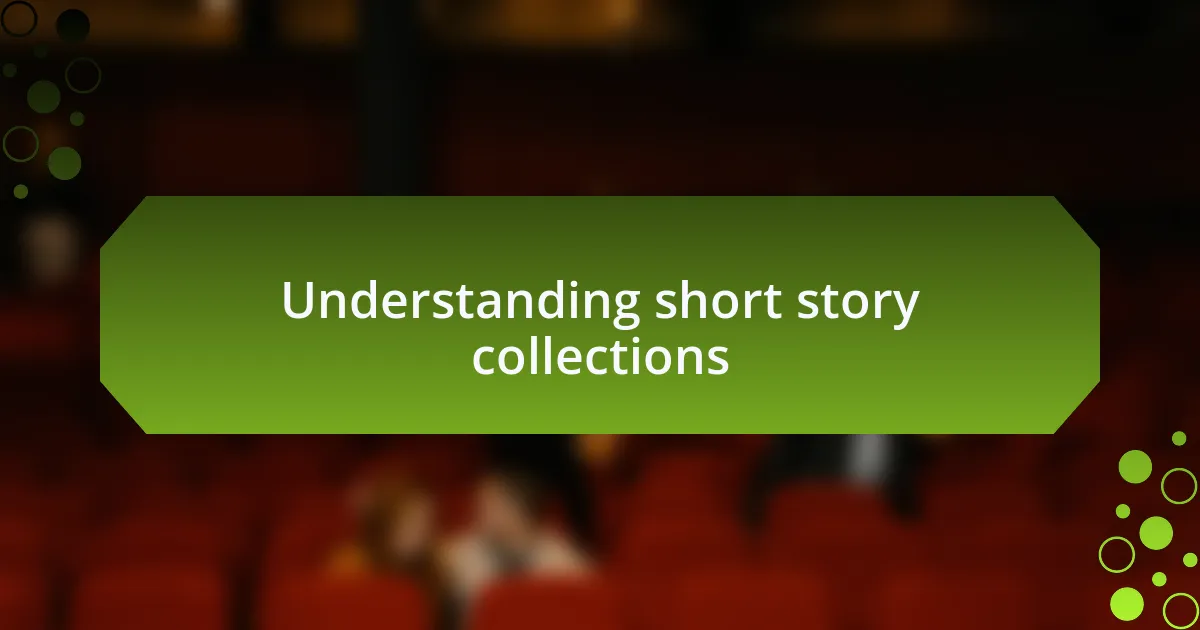Key takeaways:
- Short story collections allow for exploration of diverse themes and emotional connections through interconnected narratives.
- They provide concise, impactful storytelling that can inspire reflection and self-discovery.
- Recommendations for finding good collections include relying on online reviews, curated lists, and literary awards.
- Collections like “Interpreter of Maladies” and “The Things They Carried” convey profound lessons on vulnerability, connection, and the complexities of human experience.

Understanding short story collections
Short story collections serve as a unique platform for writers to explore diverse themes and characters in a limited space. I often find that these collections offer a glimpse into the author’s world, revealing their thoughts and emotions in ways that a single novel might not permit. Have you ever read a collection where one story resonates deeply, amplifying feelings from another? That’s the beauty of interconnected narratives.
When I pick up a short story anthology, I’m often amazed by how different each piece can feel while still tying into a central theme. These shifts allow readers to experience a range of emotions—sometimes within just a few pages. It’s like having a buffet of storytelling, where you can savor each dish without committing to a full meal. Isn’t it fascinating how a few short pages can leave a lasting impact?
Moreover, short story collections can sometimes feel like snapshots of life, capturing moments that resonate long after you’ve read them. I remember finishing a story about a fleeting encounter that lingered in my mind for weeks. It made me reflect on my own life and the brief yet meaningful interactions I’ve had. In what ways have short stories altered your perspective? It’s this emotional connection that makes collections powerful and thought-provoking.

Importance of short stories
Short stories hold immense importance because they captivate readers quickly, often packing profound insights into just a few pages. For me, it’s like diving into a new world over a cup of coffee—each story is a mini-escape that reveals truths about human nature. Haven’t you ever finished a tale and felt like it was a mirror reflecting aspects of your own life?
Additionally, the immediacy of short stories can spark inspiration and provoke thought in ways longer narratives may struggle to achieve. I recall reading a story that ignited my passion for travel—a simple narrative about a journey that opened my eyes to the beauty of exploration. It made me ponder, how often do we let the small moments in life inspire us to chase our dreams?
The format of a short story encourages authors to be concise, honing their craft to deliver powerful messages effectively. I always appreciate the beauty of economy in storytelling, where each word counts. When I find a line that resonates with me deeply, it often lingers long after I’ve closed the book. Isn’t it remarkable how a few carefully chosen words can stir emotions and insights that last a lifetime?

How to find good collections
To find a good collection of short stories, I recommend starting with online reviews and recommendations from trusted literary sources. I often rely on platforms like Goodreads to see what fellow readers have enjoyed. Have you ever noticed how recommendations can lead you to hidden gems you might not have found on your own?
Another powerful way to discover quality collections is through curated lists. Whether it’s a blog post, an article, or a social media thread, I love diving into these lists. I once stumbled upon a collection titled “The Best American Short Stories” series this way, and each story surprised me with its depth. It made me wonder, are we sometimes overlooking the gems right in front of us because we stick to our usual favorites?
Exploring literary awards can also guide you toward remarkable collections. When I see a book adorned with accolades, I can’t help but feel intrigued. For instance, the collection that won the Pushcart Prize expanded my understanding of narrative style. Isn’t it fascinating how these awards often spotlight voices that challenge and inspire us?

Streamlining your reading process
Streamlining your reading process can be a transformative experience. I like to break my reading time into manageable chunks, often setting a timer for 20 to 30 minutes. This approach not only keeps my focus sharp but also invites me to savor each story rather than plow through them mindlessly. Have you ever noticed how much richer a text feels when you give it your undivided attention?
Creating a reading schedule is another technique I’ve found invaluable. I remember when I first started organizing my reading around specific themes or genres each week. This not only kept me engaged but also allowed me to explore stories in a more coherent way. It’s remarkable how a bit of structure can lead to unexpected insights and connections between the stories.
Additionally, I often make notes or jot down thoughts as I read, which helps solidify my understanding and emotional response to each piece. This habit not only enhances my memory but also turns my reading into an active dialogue. How many times have you finished a story only to struggle to recall what you valued most? Writing these reflections down has transformed my experience, making every collection feel more like a personal journey.

My favorite short story collections
One of my absolute favorite short story collections is “Interpreter of Maladies” by Jhumpa Lahiri. I remember getting lost in her vivid portrayal of the complexities of Indian-American life, and each story felt like a little window into a different world. Have you ever read a story that resonated with your own experiences so deeply it felt like the author was speaking directly to you?
Another collection I adore is “The Things They Carried” by Tim O’Brien. This book isn’t just about the Vietnam War; it’s about the weight of memory and the struggles of storytelling itself. As I read, I often found myself reflecting on my own badges of experience, asking, “What stories am I carrying, and how do they shape me?” O’Brien’s blend of fiction and memoir plunged me into his world in a way that changed how I view my own narrative.
Lastly, I can’t overlook “Tenth of December” by George Saunders. The emotional depth of each story stayed with me long after I turned the final page. I felt an intimate connection with the characters, each navigating their own peculiar dilemmas. It leads me to wonder, do we truly understand the battles others face? Saunders gently pushes me to confront life’s absurdities and the fragile nature of our humanity.

Lessons learned from these stories
When I delve into these short story collections, I often find unexpected lessons echoing through their pages. For instance, in “Interpreter of Maladies,” I learned about the delicate threads that connect us all, regardless of cultural differences. It made me reflect on moments in my life where Bridging gaps—between people, ideas, or experiences—has fostered deeper understanding. Have you ever felt that connection spark when you least anticipated it?
Reading “The Things They Carried,” I discovered the incredible power of vulnerability in storytelling. O’Brien’s raw depiction of trauma resonated with me on a personal level, revealing how our shared experiences can unearth empathy. This really pushed me to consider the stories I’ve shied away from sharing—what would happen if I did?
With “Tenth of December,” I was struck by the reminder that life is often intertwined with absurdity and beauty. Each character’s struggle felt achingly real, prompting me to confront my own moments of confusion and uncertainty. I was left pondering: how do we find meaning in the chaos? It’s these reflections that transform my reading experience into a profound journey of self-discovery.

Recommendations for moviemaking inspired collections
When I think about short story collections that inspire filmmaking, “The Secret Life of Walter Mitty” often comes to mind. The way the stories dive deep into fantasy and reality resonates with me, showcasing how ordinary lives hold extraordinary potential. Have you ever daydreamed about your own life becoming a cinematic adventure? It’s that spark of imagination that can drive creative visuals on screen.
Another fantastic collection is “Girl, Woman, Other” by Bernardine Evaristo, which weaves together diverse narratives that highlight the complexities of identity and relationships. Each character’s journey, much like a film, unfolds in layers, prompting me to think about how we can tell multiple stories simultaneously in a single project. It’s fascinating to consider: how can juxtaposing different lives in a film enhance the audience’s understanding of the broader human experience?
Finally, I can’t overlook “Dubliners” by James Joyce. His ability to capture the essence of everyday life feels cinematic, breathing life into each mundane moment. I remember when I first read “The Sisters,” and the atmosphere seemed to hang in the air like a frame from a film. It got me pondering: in what ways can small, intimate stories translate into powerful visual storytelling? This exploration illustrates that moviemaking often starts with the heart, much like the stories we cherish.